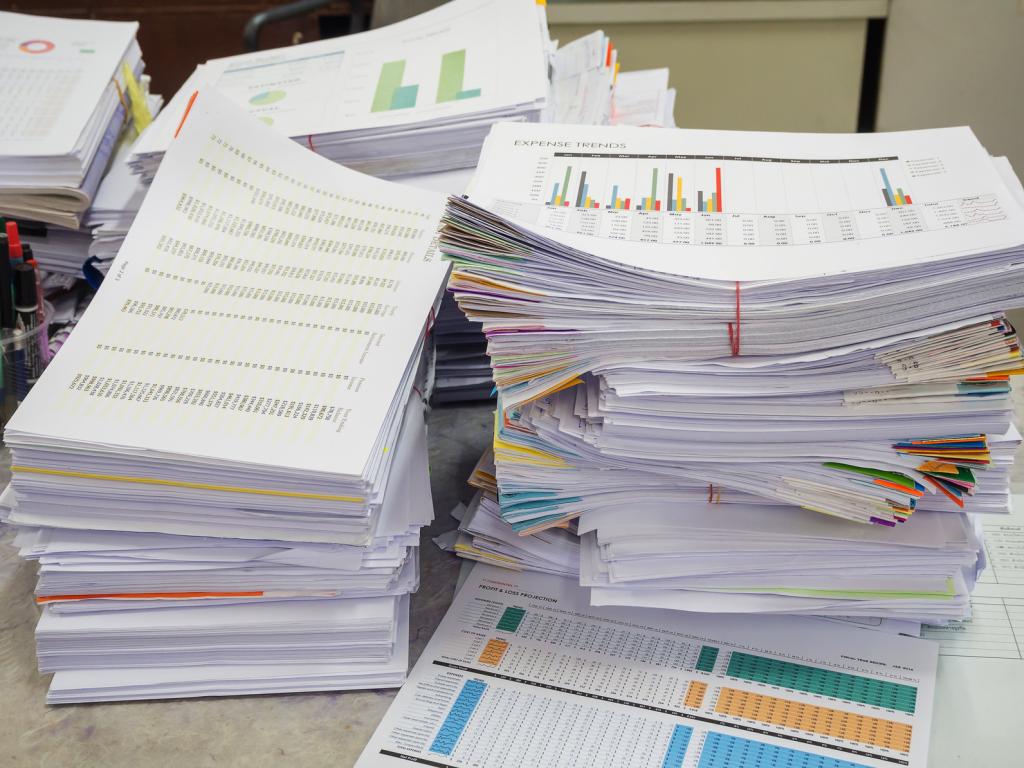Annual financial statements are a very important financial documentation, which is compiled in companies subject to mandatory preparation in accordance with standards.
Annual reporting is a very important document in the financial reporting of any organization. The relevance and accuracy of analytical data on the position of the company and the prospects for its development depend on the reliability of its compilation. According to the reporting data, you can conduct a qualitative analysis and develop prospects for the development of the company. It is possible to assess the liquidity, financial stability and solvency of the company.
Concept and purpose
The annual statements include forms of accounting documents, which are submitted once a year in the form of summary indicators. Compilation is based on data from primary accounting registers, tax data, as well as interim reporting.
The need for the formation of annual financial statements of the organization is due to several factors:
- obtaining information for the internal work of the company;
- evaluation of the company by external parties.
When preparing reports, the accountant is subject to mandatory legislation.
The legislative annual financial statements are regulated by the following acts:
- PBU 4/99 “Accounting”;
- Accounting and Accounting Position No 34n;
- Order of the Ministry of Finance of July 2, 2010 No. 66n.
Any company reporting always carries certain financial information about the company. Such information may be necessary for analysis by both the tax authorities and statistics. It is the basis for a number of decisions at the national level. With the help of this documentation, authorities also monitor the conduct of the company and its compliance with the law. In case of detection of omissions and violations, a system of penalties is applied.
In addition, these documents are used by the company itself, or rather, its management to obtain the required information about the financial situation and strategic planning. In general, the availability of such reports stabilizes the activities of the entire company and shows its prospects for development.
Composition and basic forms
Among the main forms of annual financial statements are:
- balance sheet;
- report on financial results;
- statement of changes in equity;
- cash flow statement;
- report on the targeted use of funds;
- explanations.
Decryptions of certain indicators, some additional indicators and data are mandatory attached to the papers.
Additional information may include issues such as:
- dynamics (graphical or tabular) of the main indicators over several years (usually 3 years);
- certificate of company development plans;
- investment plan;
- use of borrowed funds of the company;
- risk management fundamentals;
- environmental measures and labor safety.
For small businesses there is a composition:
- simplified accounting;
- report on financial results in a simplified form.

Change time
The terms of the annual financial statements are regulated by law.
All organizations are required to submit reports at their location until March 31 of the reporting year.
Reporting locations:
- tax service;
- territorial statistics authority.
In the case when the period of the annual financial statements falls on a day off, the dates are postponed to the next working day.
Compilation requirements
Among the main requirements are:
- reliability;
- timeliness;
- comparability;
- fullness.
Consider the requirements presented in more detail.
The main requirement before preparing the annual financial statements is the availability of reliable facts. This means that all indicators should be real, not fictitious and consistent with real facts.
The requirement of timeliness affects the quality of reporting. This means that data is only shown for the reporting period that is indicated.
Comparability of indicators is the interconnection of all these values in reporting forms and accounting registers.
The principle of completeness implies the presence of the full volume of all indicators in the statements.
In the absence of some indicators in the explanatory note separately make a reference to those values that are not considered in the reporting.
Among other requirements, one can name the materiality and neutrality of the compilation.

Who should make up?
The preparation of annual financial statements is a requirement for all types of organizations and individual entrepreneurs, with the exception of those who have the right to apply the type of reporting (or not to compile it at all), namely:
- small business;
- non-profit companies;
- Skolkovo participants.
Who is the user?
Annual financial statements - there are summary data on indicators of economic activity. Accordingly, there are many users of this information. All of them can be divided into two large groups: external and internal.
Among the internal ones, one can name the company's management, parent organizations, and management units.
Among external users, the Federal Tax Service, Rosstat, PFR, FSS, banking organizations, business partners, etc.

Formation Basics
The procedure for preparing annual financial statements by stages is presented in the table below.
| Stage | Characteristic |
| 1 | Checking the correctness of correspondence on accounting transactions for the year |
| 2 | Inventory Correction |
| 3 | If there are operations in the reporting that are identified, the accountant makes a record and conducts all events on the documents |
| 4 | Tax calculation after all checks |
| 5 | Making accounting records for accrued taxes, reformation of the balance sheet |
Reporting can be compiled by the chief accountant. Accountants who are subordinate, usually provide him with all the necessary data for the formation of documents.
This document is the final in the process of accounting for the company. It allows you to identify and trace the unity of all documentation and accounting registers.

The content of the main forms
The content of the balance sheet.
The balance sheet is based on the general ledger data for the main accounts and subaccounts at the end of the reporting period of the company. At small enterprises, the General Ledger is practically not maintained, but they are required to fill out a book of accounting for business operations. For those who store documentation with the implementation of software, all accounts, as well as the balance, are created automatically. Some balance sheet items are filled in accordance with the balances, for example, 50, 51, etc. The main documents for filling out the balance sheet are PBU 4/99.
The content of the report on financial results. Such a report includes such characteristics as:
- revenue and cost data;
- profit from operations;
- other data on income and expenses;
- tax data;
- amount of net profit.
This form consists mainly of the ratios of accounts 90 and 91. This form is required to comply with the indicators contained in the company's profit statement.
The statement of changes in equity consists of the following sections:
- Chapter 1 - “Capital” - contains such data as balances on authorized capital, reserve and additional capital;
- section 2 - “Reserves for future income” and section 3 - “Estimated reserves” - contain information about the reserves that were created in the company at the beginning of the year for doubtful debts, etc .;
- Chapter 4 - “Change in capital” - here is information about the amount of capital, its change.
The cash flow statement is created on the basis of accounts: 50 - Cashier, 51 - Settlement Account, 52 - Currency Account, 55 - Special Accounts, 57 - Transfers in transit. The report shows account balances, their movement (income and loss), etc. Information is shown on cash equivalents (investments with high solvency). Cash flows in this report are divided into current, investment, financial.
In addition to annual financial statements, companies must provide annual tax reports. They include a declaration of VAT, profit, property, transport tax (in the situation if the company has such on the balance sheet), land tax (if there is a land plot).

The timing
The delivery of annual financial statements, as mentioned above, is strictly regulated. In case of late delivery, the tax authorities have the right to fine the company in the prescribed amount for each form. Administrative responsibility is also imposed on the one who drafted the documents and the chief accountant of the company.
Initially, reporting should be submitted to company management for approval to assess the current financial situation. On the basis of the data obtained, various management decisions are possible.
At the next stage, annual financial statements are submitted to the tax inspectorate according to the established deadlines.
Annual reports may be of interest to the co-founders and creditors of the company, as they give an idea of how much trust can be given to the existing management, how successful the development strategy of the company is. Moreover, investors may be interested in the results of the organization’s work at the planning stage.

Inventory Basics
The inventory before the annual financial statements helps to get a real idea of the balances of goods and products, stocks of the company, as well as basic assets.
The organization independently sets the dates for such a procedure, its procedure and list of objects (Clause 3 of Article 11 of the Law on Accounting).
An inventory before the preparation of the annual financial statements is mandatory for the exclusion of property, the audit of which was carried out starting from October 1 of the reporting year.
The annual procedure from reporting assets and liabilities is carried out in 4 quarters.
The procedure and main stages are provided in the inventory management unit.
The main stages of the process are presented in the table below.
| Stage | Characteristic |
| Order to conduct | It indicates: - positions of members of the commission; - reason for carrying out; - dates; - types of objects. |
| Checking objects by deadlines | Checked: - property available (name and quantity); - cash, accounts, intangible assets, financial investments; - accounts receivable and payable; - other objects. |
| Reconciliation of received values with reporting data | Deviations are recorded in the collation statements |
| Drawing up a summary statement | Surpluses and deficiencies are identified, the method of their reflection in the reporting is indicated. |

New in preparation in 2019
In 2019, certain amendments were made to the legislation, which will need to be taken into account when submitting reports for 2019. The main ones are reflected in the table below.
| Reporting | What's new |
| Annual financial statements | - there is no need to submit forms to Rosstat; - electronic version of reporting (except for small business) using enhanced digital signature. |
Responsibility for Violations
If the company is late in submitting reports to the tax office, the FSS or the FIU, it will receive fines.
The penalty for this violation is five percent of the amount of tax payments or contributions assessed for the entire period or for the past 3 months of the period for which the report is overdue. The billing period depends on the type of report. For tax payments - from the amount of the declaration, for contributions - from the amount for the past three months.
The delay period starts on the day following the last due date. Both full and incomplete months are taken into account. You will need to pay at least 1000 rubles for late payment. The fine will be about 30% of the amount of insurance payments.
In the absence of financial reporting on tax payments and to state statistics authorities, administrative fines may also be imposed.
A fine from the Federal Tax Service - 200 rubles for each form of non-delivered reporting. For example, if an organization provides only a balance sheet and a report on financial results, the fine will be 400 rubles.
The head of the company and the organization’s accountant may be fined between 300 and 500 rubles.
The fine from the state statistics service is from 3,000 to 5,000 rubles for failure to provide or non-completion of all forms.

Error correction
During the preparation of annual financial statements, mistakes are often made. They can be both technical and methodological, arithmetic, program, etc.
Methodological errors are often associated with incorrect matching of accounts, lack of documents when reflecting financial transactions, etc.
You can correct the above errors during the preliminary work on the preparation of reports. There are several rules for correcting miscalculations. If, by the end of the reporting year, erroneously reflected business activity of the current period is revealed, the changes are made by means of entries in the respective accounts in the month of the reporting period in which the transactions were established.
In cases where the organization reveals in the current reporting period the incorrect reflection of financial transactions on accounts in the past year, the financial statements and accounting for the last reporting year are corrected. Such errors are reflected in the reporting period. If these shortcomings affect the amount of the monetary result, then they are reflected in account 91 as profit or loss for previous years that were recognized in the reporting year.
As a result, December entries can be corrected accordingly. They are issued on the basis of accounting statements with the required details of the original document, as defined in Art. 9 p. 2 of the Law on Accounting.
Conclusion
The main important points regarding the annual financial statements of the company:
- compiled by the company's accountant (chief accountant);
- necessary for internal and external analysis and evaluation of the company;
- the basic principle of compilation is the correct design and reliability of the data;
- the main forms are the balance sheet and the report on financial results;
- there is special legislation to regulate the processes of formation and submission of reports;
- reporting should be provided within 90 days from the end of the year and not earlier than 60 days.
Annual reporting is the main form of documentation at the enterprise, which provides informational transparency of the subject. This form is subject to approval by the management of the company. Responsibility lies with the chief accountant. This report is practically the most important document, thanks to which you can assess the current financial situation of the company, as well as predict future indicators.









